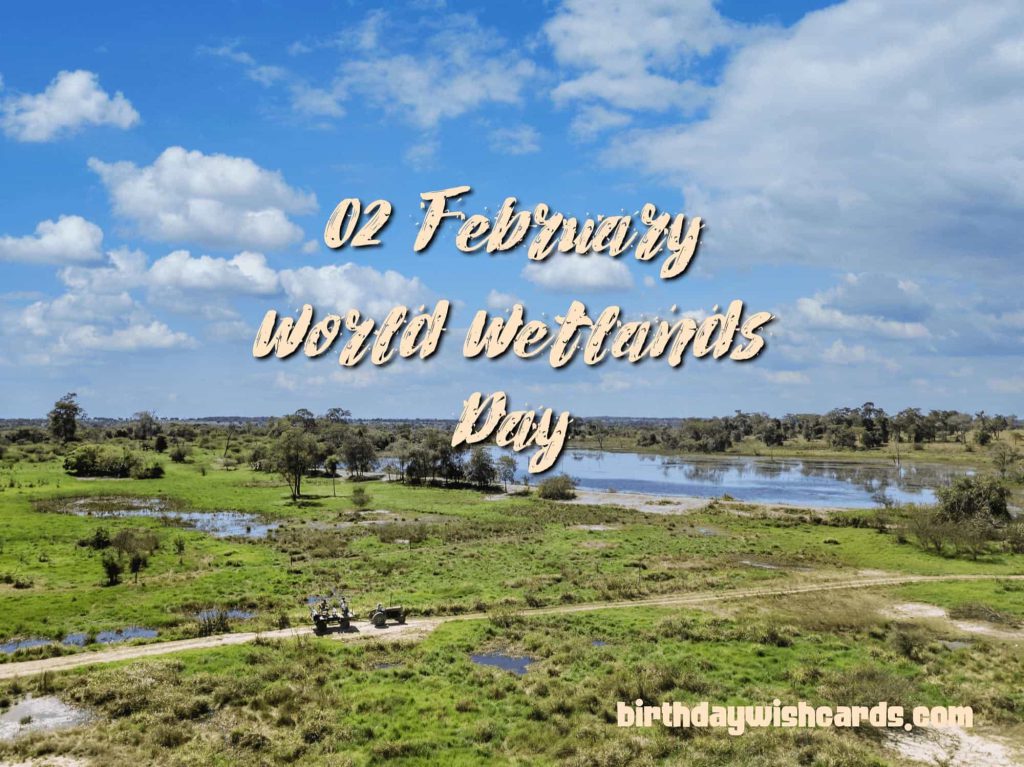
02 February: World Wetlands Day 2024
Introduction to World Wetlands Day
World Wetlands Day is observed annually on 2 February to raise global awareness about the vital role wetlands play in maintaining ecological balance and supporting biodiversity. Established in 1997, this day is dedicated to highlighting the importance of wetlands and advocating for their conservation and sustainable use worldwide.
Countries around the world mark the occasion with a variety of activities designed to increase public understanding of wetland values. These include lectures, seminars, nature walks, children’s art contests, community clean-ups, boat races, media campaigns, and announcements of new wetland protections or Ramsar Site designations.
The Importance of Wetlands
Wetlands rank among the most productive ecosystems on Earth, providing a wealth of environmental, economic, and social benefits. Their key ecological functions include:
- Providing essential habitat and food for a wide range of fish, birds, and wildlife, including many threatened and endangered species.
- Improving water quality by filtering pollutants and trapping sediments.
- Storing floodwaters and reducing the impacts of storms and droughts.
- Controlling coastal erosion and buffering shorelines against wave action.
- Sequestering carbon, thus helping to mitigate climate change.
- Offering opportunities for recreation, education, and scientific research.
World Wetlands Day 2021 Theme: “Wetlands and Water”
The theme for World Wetlands Day 2021 was “Wetlands and Water”, emphasizing the crucial role wetlands play as sources of freshwater. This theme called for urgent action to restore degraded wetlands and prevent further loss, highlighting their importance for water security and ecosystem health.
Wetlands naturally enhance water quality, regulate river flows, and act as natural sponges that absorb excess rainfall and floodwaters. One of the world’s largest and most pristine tropical wetlands is the Pantanal, spanning more than 42 million acres across Bolivia, Brazil, and Paraguay. This vast ecosystem supports millions of people and a remarkable diversity of wildlife in the Rio de la Plata Basin region.
Human Impact on Wetland Degradation
Despite their significance, wetlands are increasingly threatened by human activities that lead to their degradation and loss, disrupting natural balances and diminishing ecosystem services. Major human-induced impacts include:
Dredging and Sand Mining
Dredging, which involves removing sediments from wetland or riverbeds, lowers the local water table and can dry out adjacent wetlands. Sand mining further disturbs wetland habitats, altering water flow and sediment balance.
Introduction of Invasive Species
Non-native plant species such as water hyacinth and Salvinia have invaded many wetlands, particularly in India. These invasive species can choke waterways, reduce oxygen levels, and displace native plants and animals, fundamentally altering the ecosystem.
Pollution and Land Conversion
Industrial discharges, agricultural runoff, and urban development introduce pollutants and change water flow, degrading wetland quality. Wetlands are also frequently drained or filled for agriculture, infrastructure, or housing, resulting in permanent loss of these vital areas.
Global Efforts to Protect Wetlands
International cooperation is essential for wetland conservation. The Ramsar Convention on Wetlands, established in 1971, is a global treaty dedicated to the conservation and wise use of wetlands. Over 170 countries are signatories, committing to protect sites of international importance and promote sustainable management practices.
On World Wetlands Day, countries launch educational initiatives, restore degraded wetlands, and designate new Ramsar Sites. These efforts foster greater understanding of wetlands’ value and encourage communities to participate in their preservation.
Benefits of Wetlands to Society
Wetlands provide numerous benefits that positively impact society:
- Biodiversity Support: Wetlands are crucial habitats for many fish, bird, amphibian, and plant species, including several that are endangered.
- Water Quality Improvement: Acting as natural filters, wetlands absorb pollutants and sediments, improving freshwater quality.
- Flood Mitigation: Wetlands store excess rainwater and floodwaters, reducing flood risks for nearby communities.
- Coastal Protection: Wetlands stabilize shorelines by preventing erosion and buffering against wave action.
- Economic Resources: Wetlands provide natural products such as fish, reeds, and medicinal plants, supporting local economies.
- Recreational and Educational Opportunities: Wetlands offer valuable spaces for tourism, birdwatching, scientific research, and environmental education.
How You Can Help Protect Wetlands
Everyone can play a part in wetland conservation through simple, everyday actions:
- Join local wetland clean-up and restoration projects.
- Support policies and organizations dedicated to wetland protection.
- Reduce pollution by minimizing the use of pesticides and chemicals near water bodies.
- Avoid draining or filling wetlands for development.
- Raise awareness about the importance of wetlands in your community.
Visual Celebration of Wetlands
These images celebrate the beauty and diversity of wetlands around the world, underscoring the importance of preserving these vital ecosystems for ecological health and human well-being.
Conclusion
World Wetlands Day is a powerful reminder of the invaluable contributions wetlands make to biodiversity, climate regulation, and human livelihoods. Protecting these ecosystems requires both global collaboration and local action to ensure that future generations continue to benefit from their ecological services.
By understanding the threats wetlands face and embracing sustainable practices, we can safeguard these critical habitats. Join the global movement to celebrate and conserve wetlands every year on 2
